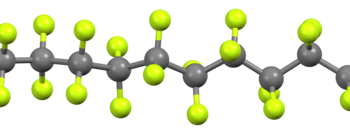History and Production
- PTFE was accidentally discovered in 1938 by Roy J. Plunkett while working for DuPont.
- Kinetic Chemicals patented the new fluorinated plastic in 1941 and registered the Teflon trademark in 1945.
- DuPont started producing over 2,000,000 pounds of Teflon per year in 1948.
- PTFE was used in the Manhattan Project to coat valves and seals.
- Non-stick cookware was created in 1954 by Marc Grégoire and Marion A. Trozzolo.
- PTFE is produced by free-radical polymerization of tetrafluoroethylene.
- Special apparatus is required to prevent explosive decomposition of tetrafluoroethylene.
- Granular PTFE is produced via suspension polymerization or emulsion polymerization.
- Toxic surfactants like PFOA and PFOS were previously used, but alternative surfactants are now being used.
- The production process involves hydrolyzing sulfate ester groups to give OH end-groups.
Properties
- PTFE is a white solid with a density of about 2200kg/m and a melting point of 600K.
- It maintains high strength, toughness, and self-lubrication at low temperatures.
- PTFE gains its properties from carbon-fluorine bonds.
- Highly reactive metals and fluorinating agents can affect these bonds.
- PTFE undergoes depolymerization at temperatures above 650–700°C.
Applications
- PTFE is used as a non-stick coating for pans and other cookware.
- It is used in containers and pipework for reactive and corrosive chemicals.
- PTFE reduces friction, wear, and energy consumption in machinery.
- It is used as a graft material in surgery and as a coating on catheters.
- PTFE is widely applied in various industries and products.
Environmental Impact
- PTFE is a PFAS and a persistent organic pollutant.
- The environmental impact and toxicity to human and mammalian life have been studied since the 21st century.
- DuPont used PFOA during PTFE production, leading to legal actions and discontinuation of its use.
- Chemours now manufactures PTFE using an alternative chemical called GenX.
- PFAS, including PTFE, have raised concerns due to their persistence and potential health effects.
Additional Applications
- PTFE is commonly used for wire insulation in aerospace and computer applications due to its excellent dielectric properties.
- PTFE is used for plain bearings, gears, seals, gaskets, and other applications with sliding action of parts.
- PTFE is an ideal material for fabricating long-life electrets, which are electrostatic analogues of permanent magnets.
- PTFE film is widely used in the production of carbon fiber composites and fiberglass composites in the aerospace industry.
- PTFE is commonly used as a chemically inert liner in hose assemblies, expansion joints, and industrial pipelines.
Polytetrafluoroethylene (PTFE) is a synthetic fluoropolymer of tetrafluoroethylene and is a PFAS that has numerous applications. The commonly known brand name of PTFE-based composition is Teflon by Chemours, a spin-off from DuPont, which originally discovered the compound in 1938.
 | |
 | |
| Names | |
|---|---|
| IUPAC name Poly(1,1,2,2-tetrafluoroethylene) | |
| Other names Fluon, Poly(tetrafluoroethene), Poly(difluoromethylene), Poly(tetrafluoroethylene), teflon | |
| Identifiers | |
| Abbreviations | PTFE |
| ChEBI | |
| ChemSpider |
|
| ECHA InfoCard | 100.120.367 |
| KEGG | |
| UNII | |
CompTox Dashboard (EPA) | |
| Properties | |
| (C2F4)n | |
| Density | 2200 kg/m3 |
| Melting point | 327 °C |
| Electrical resistivity | 1018 Ω·cm |
| Thermal conductivity | 0.25 W/(m·K) |
| Hazards | |
| NFPA 704 (fire diamond) | |
Except where otherwise noted, data are given for materials in their standard state (at 25 °C [77 °F], 100 kPa). | |
Polytetrafluoroethylene is a fluorocarbon solid, as it is a high-molecular-weight polymer consisting wholly of carbon and fluorine. PTFE is hydrophobic: neither water nor water-containing substances wet PTFE, as fluorocarbons exhibit only small London dispersion forces due to the low electric polarizability of fluorine. PTFE has one of the lowest coefficients of friction of any solid.
Polytetrafluoroethylene is used as a non-stick coating for pans and other cookware. It is non-reactive, partly because of the strength of carbon–fluorine bonds, so it is often used in containers and pipework for reactive and corrosive chemicals. Where used as a lubricant, PTFE reduces friction, wear, and energy consumption of machinery. It is used as a graft material in surgery and as a coating on catheters.
PTFE is one of the best-known and widely applied PFAS commonly described as persistent organic pollutants or "forever chemicals". Only since the start of the 21st century has the environmental impact and toxicity to human and mammalian life been studied in depth. For decades, DuPont used perfluorooctanoic acid (PFOA, or C8) during production of PTFE, later discontinuing its use due to ecotoxicological and health issues that led to legal actions. Dupont's spin-off Chemours today manufactures PTFE using an alternative chemical it calls GenX, another PFAS.
poly- + tetrafluoroethylene
polytetrafluoroethylene (countable and uncountable
... Read More